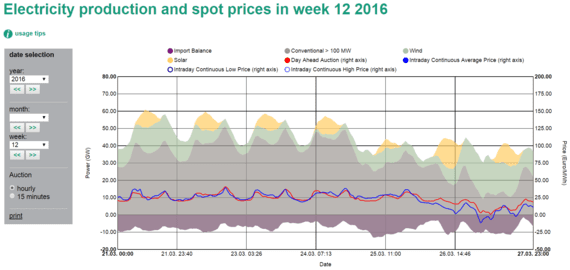Power exports to the rescue over the Easter weekend, when conventional power generation hovered at 10 gigawatts for some 15 hours – half the must-run level. Power exports brought the country’s conventional fleet backup to that level.
Over the Easter weekend, power demand in Germany fell from a normal workday peak of around 60 GW down to around 45 GW during the day – but closer to 30 GW at night. With wind power production exceeding 20 gigawatts and solar also kicking in at above 10 gigawatts on Easter Sunday, conventional power generation was pushed dangerously low for a full 15 hours last Sunday.

Over the Easter weekend, power demand in Germany fell from a normal workday peak of around 60 GW down to around 45 GW during the day – but closer to 30 GW at night.
With wind power production exceeding 20 gigawatts and solar also kicking in at above 10 gigawatts on Easter Sunday, conventional power generation was pushed dangerously low for a full 15 hours last Sunday.
Interestingly, power trading saw low prices all week, but not particularly low on Sunday. The chart (from Fraunhofer’s EnergyCharts.de) differs a bit from the Epex Spot website, but both show positive day ahead prices throughout the Easter weekend.
Strangely, on Easter Monday (a federal holiday throughout Germany) there seems to have been a sudden plunge into the negative for intraday trading, which goes completely off Fraunhofer’s chart. Epex lists pricesdown to -4 cents per kilowatt-hour. Intraday prices are an indication of forecast inaccuracies, in terms of both demand and production.
With conventional power having been pushed so low already, it’s hard to explain why prices would be negative had solar and/or wind of falling short of the forecast; in that case, conventional plants would have had to run more, not less. Perhaps the problem was that demand fell short of expectations.
Conventional power generation being pushed down to around 10 gigawatts is still a fairly rare occurrence; a quick look at Fraunhofer charts for 2015 reveals that it happened a handful of times last year and often resulted in negative prices. But the only time when conventional production remained so low for so long seems to have been December 26 (for around 18 hours).
A few years ago, such low levels would have led to concern about grid reliability, but there have been no reports of any trouble.
Source: Renewables International. Reproduced with permission.







